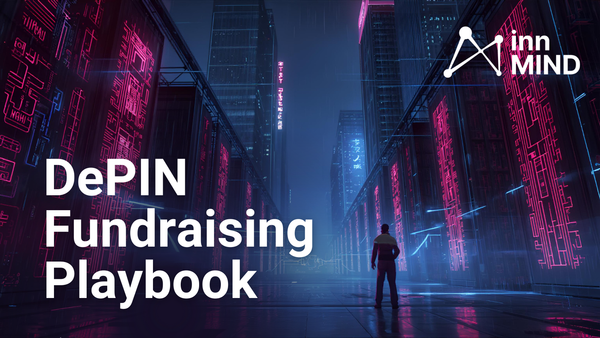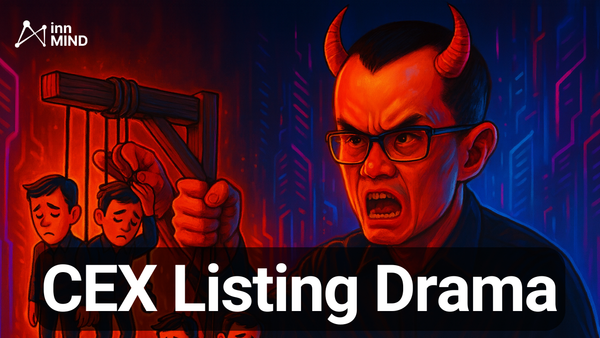The Key Steps to Securing Investment from Crypto VCs
We've put together some fundamental steps for blockchain startups looking to successfully secure investment from Venture Capital firms - how many of these steps have you completed?

Data shows that venture capital funding for blockchain startups reached USD 25.2 billion in 2021, which is an increase of 713% from $3.1 billion in 2020. With the momentum still firmly advancing, it could mean we’re on track to see a record year for VC-backed investments in the blockchain space in 2022.
Venture capitalists seek emerging blockchain startups where they can invest millions of dollars and get returns in multiple folds. Because of the large amount of capital involved and returns expected, the fundraising process is usually rigorous.
That's why we’ve broken down the process into some key steps to ensure you're able to secure funding from institutional investors for your company.
InnMind host pitching sessions to get in front of a wide variety of VC firms. If you're interested in getting involved, you can read more here.
The Key Steps to Securing Venture Capital Funding for your Crypto Startup
Investors know blockchain technology is the future, and they are willing to back businesses with profitable ideas. However, there are hundreds of emerging Web3 startups seeking investments from venture capitalists so if you are going up against the competition, you need to be adequately prepared to impress your prospective VCs.
Here are the steps to successfully secure VC investment for your crypto and blockchain startup:
Build your team and credibility
You have got a brilliant blockchain idea with a massive use case... Great! But it is not yet time for you to get venture capital funding for your crypto project. You have to develop the product (Dapp) prototype or service and get your first customers.
But you may not be able to do this alone. So the first important step to launching a successful VC-backed fundraiser is to get your team together. And name-dropping is a way of getting their attention.
Build an expert management team
A key step to getting venture capitalists to back your blockchain startup is getting the right and credible experts on your business team.
Venture capitalists love to know they are working with capable hands. So they are interested in knowing if you or your team member has built a company before and the impact and expertise of your team members in the crypto, blockchain, and tech space. Have you or any member of your management team raised VC funding in the past? Institutional investors would like to know this information.
Credibility is one of the most important things venture investors look out for when investing in blockchain projects.
Get a reputable advisory team
Who are your board members, advisory members, business mentor, attorneys, and bankers?
Your advisory team members should have the experience to guide you through your startup and fundraising journey. Also, venture investors will be excited to know that other reputable angel investors are backing your Web3 project. The more reputable names you have on your team, the higher your chances of securing VC funding.
Prepare a project roadmap and your documents
After building your team, developing your crypto-assets and products, and bringing it all to market, you need to create a roadmap for the project.
Your roadmap will give potential venture investors a sense of direction and instil confidence in them - especially if you have got a reputable team.
Once this is done, it is time to get your investment documents sorted out. What documents do you need? Here's a list:
Write your white paper
Before backing your crypto project, institutional investors will be interested in seeing your white paper. Your crypto white paper should explain the technical aspects of your project. It should contain data that is easy to understand and presented as formulas, diagrams, and statistics that will highlight the purpose of your project.
Business Plan
If you have not written a concrete company business plan, now is the time to do it.
The most important part of your plan is your executive summary which should be concise and restricted to one or two pages. It should be compelling enough to get prospective investors interested in reading further into your business plan.
Pitch Deck
Putting together a well-thought-out pitch deck is a great step to raising venture capital funding. Venture capitalists often get lots of pitch decks, so if yours is not persuasive enough, you will probably not get funded.
Effective pitch decks are usually between 8 and 20 slides long. Here are the details your pitch deck should address;
- The problem your Web3 product/service solves
Describe the pain points or reasons you developed your product or service. This will position you to discuss the solution your blockchain startup is offering.
- How your crypto project will solve the problem
While describing how your blockchain product/service can solve the problem, demonstrate how you can scale your solution to the investors. Describe the solution in terms of the dollar amount.
- The market size and opportunity
Talk about the size of your existing and target customers and the opportunity your product or service has in the current market. Also, tell investors the verticals you are looking to diversify into and the growth potential of the market.
- Your product/service description
Your pitch deck should detail the features that make your minimum viable product unique. Highlight the innovation your product or service brings to the crypto space that your competitors do not have. Also, let investors know your product's performance and showcase testimonials.
- Your team members
Your pitch deck will not be complete without having a slide tell your investors your team's educational and experience background.
- Your competitors
While it is good that your Web3 product or service is the first solution to a problem, it may be better if you have competition as that will help you validate the market. Let your investors know your competitive advantage.
- Financial projections
You should include your 3 to 5-year financial projections to achieve profitability in your pitch deck. Do not over or under-promise: instead, justify your projections.
- Amount of funds needed
Instead of showing a fixed amount, your pitch deck should show a range so you can also look attractive to VCs that have a limit to the amount they’re willing to invest.
Create a venture capital firms wishlist
When you have got all your documents in place, it is time to put together a list of potential investors.
You can begin your search by combing through the websites of other blockchain startups and tech companies. Check out the venture capital investors that have invested in the crypto space. Also, find the projects and industries these crypto venture capitalists have invested in.
The reason for this is that an investor may focus on technology companies but might be unenthusiastic about cryptocurrencies. Some may be interested in verticals such as virtual reality, SaaS and enterprise software, etc. Also, some may prefer funding DeFi projects to other industries.
Also research their check sizes, fundraising terms, and preferred investment stages or fundraising rounds (for example, early, middle, and late). It also makes sense to prioritize investors based on location as investors love in-person connections.
This piece of information will help you know investors that will be more or the least interested in your blockchain project.
Enter your data into a spreadsheet to track your progress and prioritize your list based on proximity and best fit for your blockchain business.
When you are done compiling your list, you do not go for the kill instantly. It is time to pick your best entry points and network your way into meetings.
Networking
There are several ways to get the attention of potential investors to back your project, but probably the least effective is cold emailing – this should not be a part of your strategy as only a few VCs will source deals this way.
The most popular ways of networking are introductions, private equity conferences, competitions or accelerators, and public relations.
Of course, the best way to connect with a VC is through the InnMind platform - where you can get a basic membership for free - or our VC Pitching Sessions.
You can also apply for competitions or accelerator programs that VCs attend. Attending incubator-related and independent competitions as a blockchain startup founder is a great in two ways. First, it allows you to raise funding for your project. Second, you get the chance to connect with VCs that may be interested in your project or mentoring you.
Another great way to get your Web3 project in front of venture capitalists is by attracting good PR. A mention in an article or podcast on a high-profile tech or business blog or media company can put your startup on the radar of VC firms.
You can also speak to InnMind about promoting your startup in our weekly newsletter or in our Telegram channel.
Practice your elevator pitch
Now that you’ve assembled your documents, pitch deck, and list of potential VC firms, prepare your elevator pitch. You should highlight your vision, value proposition, and positioning for success. Ensure you make it as persuasive and succinct as possible.
Practice your elevator pitch in front of critics such as your advisory board that will spot weaknesses in your speech and ask you tough questions.
If you want to know how to create a great elevator pitch, you can check out InnMind's video guide.
Pitching investors/selling yourself
When you are done with all these steps and found a potential VC to partner with, it is time to go put on a show and negotiate the fundraising deal and terms that will work for everyone.
For more information, join our mailing list below or get started with your free InnMind account today.





